Critical Analysis of Perioperative Nursing and Surgical Safety Issues
VerifiedAdded on 2022/08/23
|8
|1964
|13
Essay
AI Summary
This essay provides a critical analysis of the perioperative nurse's role in ensuring patient safety within the surgical setting. It explores the importance of adhering to safety precautions and aligning services with health domains, including patient safety, behavioral responses, and physiological responses. The paper focuses on wrong-site surgeries, identifying potential causes such as multiple surgeons, distractions, time constraints, human factors, new techniques, equipment issues, stress, fatigue, medication errors, and poor communication. It emphasizes the need for establishing safety measures, training, and supervision, along with proper communication and verification protocols. The essay highlights interventions like surgical checklists and timeouts to prevent errors and improve patient outcomes. The analysis incorporates several research papers to support the arguments and emphasize the importance of a collaborative approach among the surgical team to ensure patient safety. The paper also touches on factors that can lead to errors, such as fatigue and stress, and the need for healthcare organizations to follow working hours limitations. The essay concludes with a reiteration of the critical need for advanced strategies to prevent wrong-site surgeries and the importance of the perioperative nurse's role in safeguarding the patient.
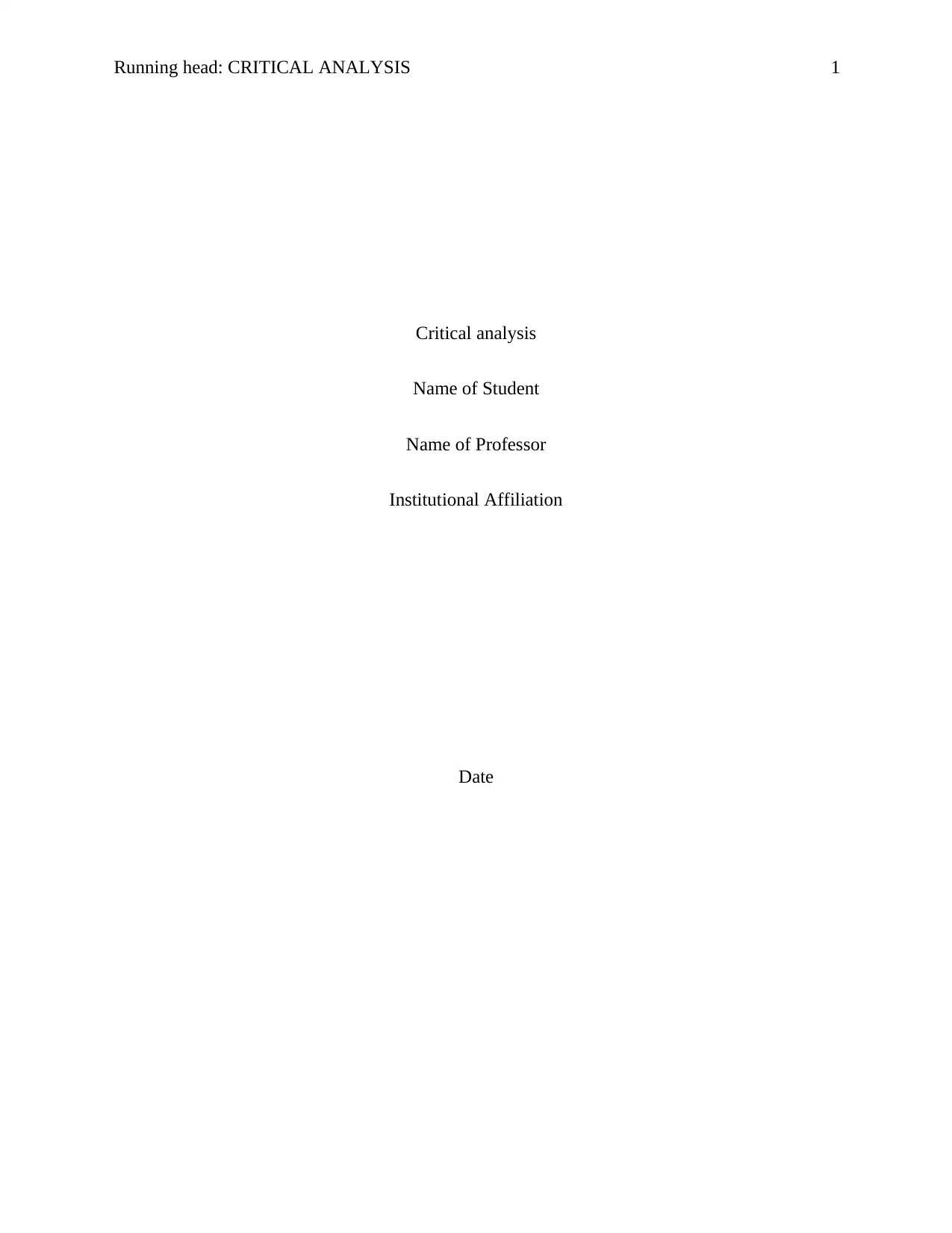
Running head: CRITICAL ANALYSIS 1
Critical analysis
Name of Student
Name of Professor
Institutional Affiliation
Date
Critical analysis
Name of Student
Name of Professor
Institutional Affiliation
Date
Paraphrase This Document
Need a fresh take? Get an instant paraphrase of this document with our AI Paraphraser
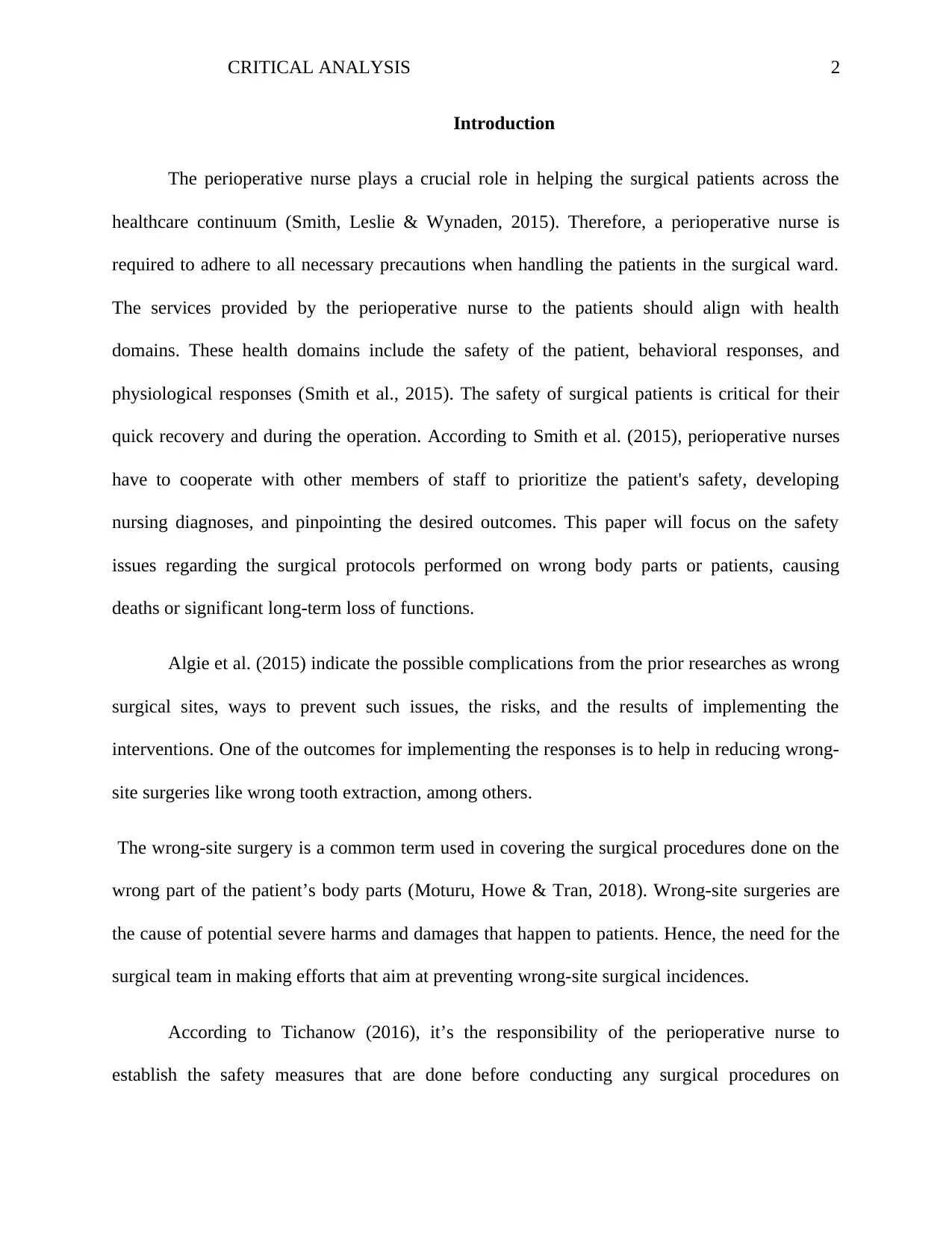
CRITICAL ANALYSIS 2
Introduction
The perioperative nurse plays a crucial role in helping the surgical patients across the
healthcare continuum (Smith, Leslie & Wynaden, 2015). Therefore, a perioperative nurse is
required to adhere to all necessary precautions when handling the patients in the surgical ward.
The services provided by the perioperative nurse to the patients should align with health
domains. These health domains include the safety of the patient, behavioral responses, and
physiological responses (Smith et al., 2015). The safety of surgical patients is critical for their
quick recovery and during the operation. According to Smith et al. (2015), perioperative nurses
have to cooperate with other members of staff to prioritize the patient's safety, developing
nursing diagnoses, and pinpointing the desired outcomes. This paper will focus on the safety
issues regarding the surgical protocols performed on wrong body parts or patients, causing
deaths or significant long-term loss of functions.
Algie et al. (2015) indicate the possible complications from the prior researches as wrong
surgical sites, ways to prevent such issues, the risks, and the results of implementing the
interventions. One of the outcomes for implementing the responses is to help in reducing wrong-
site surgeries like wrong tooth extraction, among others.
The wrong-site surgery is a common term used in covering the surgical procedures done on the
wrong part of the patient’s body parts (Moturu, Howe & Tran, 2018). Wrong-site surgeries are
the cause of potential severe harms and damages that happen to patients. Hence, the need for the
surgical team in making efforts that aim at preventing wrong-site surgical incidences.
According to Tichanow (2016), it’s the responsibility of the perioperative nurse to
establish the safety measures that are done before conducting any surgical procedures on
Introduction
The perioperative nurse plays a crucial role in helping the surgical patients across the
healthcare continuum (Smith, Leslie & Wynaden, 2015). Therefore, a perioperative nurse is
required to adhere to all necessary precautions when handling the patients in the surgical ward.
The services provided by the perioperative nurse to the patients should align with health
domains. These health domains include the safety of the patient, behavioral responses, and
physiological responses (Smith et al., 2015). The safety of surgical patients is critical for their
quick recovery and during the operation. According to Smith et al. (2015), perioperative nurses
have to cooperate with other members of staff to prioritize the patient's safety, developing
nursing diagnoses, and pinpointing the desired outcomes. This paper will focus on the safety
issues regarding the surgical protocols performed on wrong body parts or patients, causing
deaths or significant long-term loss of functions.
Algie et al. (2015) indicate the possible complications from the prior researches as wrong
surgical sites, ways to prevent such issues, the risks, and the results of implementing the
interventions. One of the outcomes for implementing the responses is to help in reducing wrong-
site surgeries like wrong tooth extraction, among others.
The wrong-site surgery is a common term used in covering the surgical procedures done on the
wrong part of the patient’s body parts (Moturu, Howe & Tran, 2018). Wrong-site surgeries are
the cause of potential severe harms and damages that happen to patients. Hence, the need for the
surgical team in making efforts that aim at preventing wrong-site surgical incidences.
According to Tichanow (2016), it’s the responsibility of the perioperative nurse to
establish the safety measures that are done before conducting any surgical procedures on
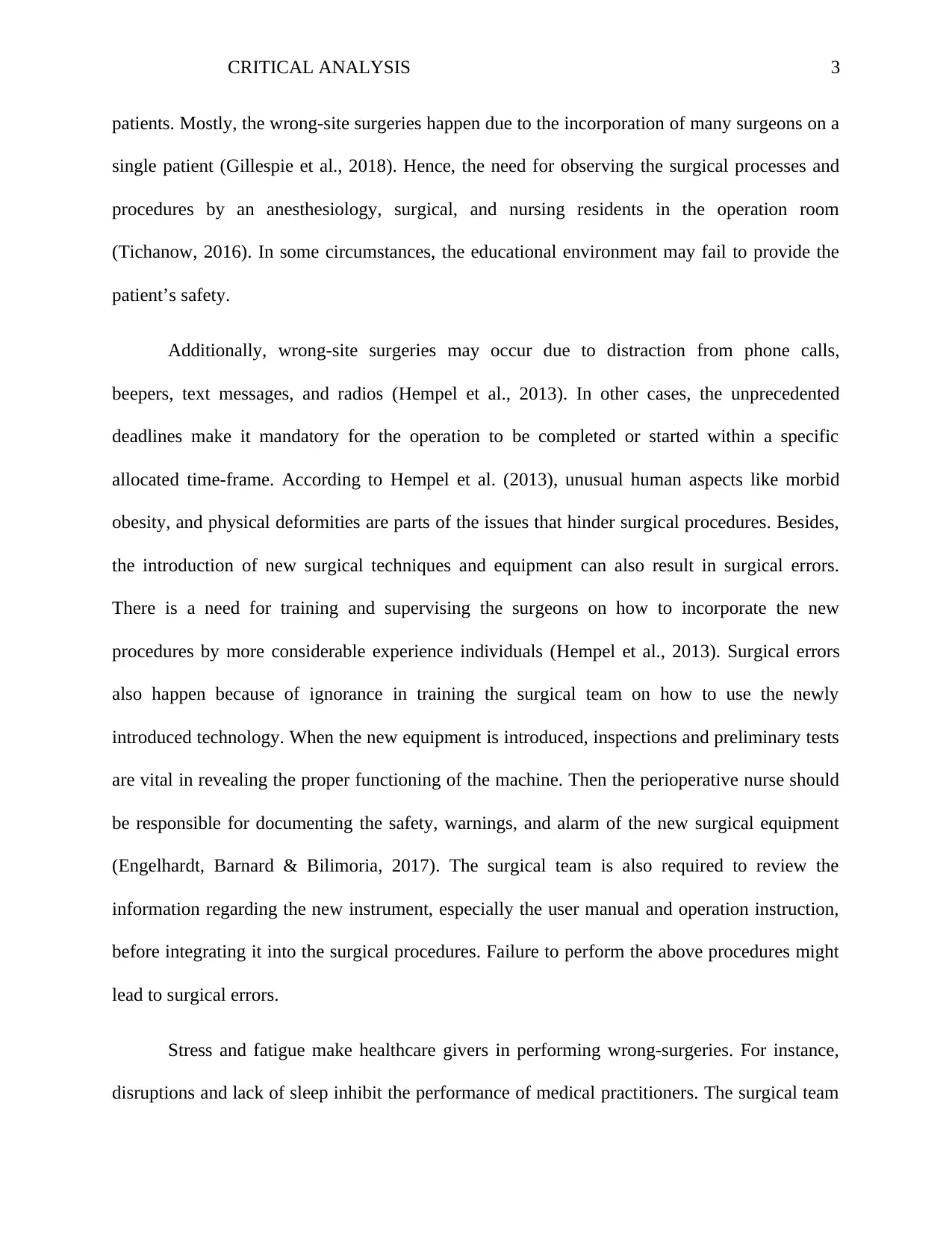
CRITICAL ANALYSIS 3
patients. Mostly, the wrong-site surgeries happen due to the incorporation of many surgeons on a
single patient (Gillespie et al., 2018). Hence, the need for observing the surgical processes and
procedures by an anesthesiology, surgical, and nursing residents in the operation room
(Tichanow, 2016). In some circumstances, the educational environment may fail to provide the
patient’s safety.
Additionally, wrong-site surgeries may occur due to distraction from phone calls,
beepers, text messages, and radios (Hempel et al., 2013). In other cases, the unprecedented
deadlines make it mandatory for the operation to be completed or started within a specific
allocated time-frame. According to Hempel et al. (2013), unusual human aspects like morbid
obesity, and physical deformities are parts of the issues that hinder surgical procedures. Besides,
the introduction of new surgical techniques and equipment can also result in surgical errors.
There is a need for training and supervising the surgeons on how to incorporate the new
procedures by more considerable experience individuals (Hempel et al., 2013). Surgical errors
also happen because of ignorance in training the surgical team on how to use the newly
introduced technology. When the new equipment is introduced, inspections and preliminary tests
are vital in revealing the proper functioning of the machine. Then the perioperative nurse should
be responsible for documenting the safety, warnings, and alarm of the new surgical equipment
(Engelhardt, Barnard & Bilimoria, 2017). The surgical team is also required to review the
information regarding the new instrument, especially the user manual and operation instruction,
before integrating it into the surgical procedures. Failure to perform the above procedures might
lead to surgical errors.
Stress and fatigue make healthcare givers in performing wrong-surgeries. For instance,
disruptions and lack of sleep inhibit the performance of medical practitioners. The surgical team
patients. Mostly, the wrong-site surgeries happen due to the incorporation of many surgeons on a
single patient (Gillespie et al., 2018). Hence, the need for observing the surgical processes and
procedures by an anesthesiology, surgical, and nursing residents in the operation room
(Tichanow, 2016). In some circumstances, the educational environment may fail to provide the
patient’s safety.
Additionally, wrong-site surgeries may occur due to distraction from phone calls,
beepers, text messages, and radios (Hempel et al., 2013). In other cases, the unprecedented
deadlines make it mandatory for the operation to be completed or started within a specific
allocated time-frame. According to Hempel et al. (2013), unusual human aspects like morbid
obesity, and physical deformities are parts of the issues that hinder surgical procedures. Besides,
the introduction of new surgical techniques and equipment can also result in surgical errors.
There is a need for training and supervising the surgeons on how to incorporate the new
procedures by more considerable experience individuals (Hempel et al., 2013). Surgical errors
also happen because of ignorance in training the surgical team on how to use the newly
introduced technology. When the new equipment is introduced, inspections and preliminary tests
are vital in revealing the proper functioning of the machine. Then the perioperative nurse should
be responsible for documenting the safety, warnings, and alarm of the new surgical equipment
(Engelhardt, Barnard & Bilimoria, 2017). The surgical team is also required to review the
information regarding the new instrument, especially the user manual and operation instruction,
before integrating it into the surgical procedures. Failure to perform the above procedures might
lead to surgical errors.
Stress and fatigue make healthcare givers in performing wrong-surgeries. For instance,
disruptions and lack of sleep inhibit the performance of medical practitioners. The surgical team
⊘ This is a preview!⊘
Do you want full access?
Subscribe today to unlock all pages.

Trusted by 1+ million students worldwide
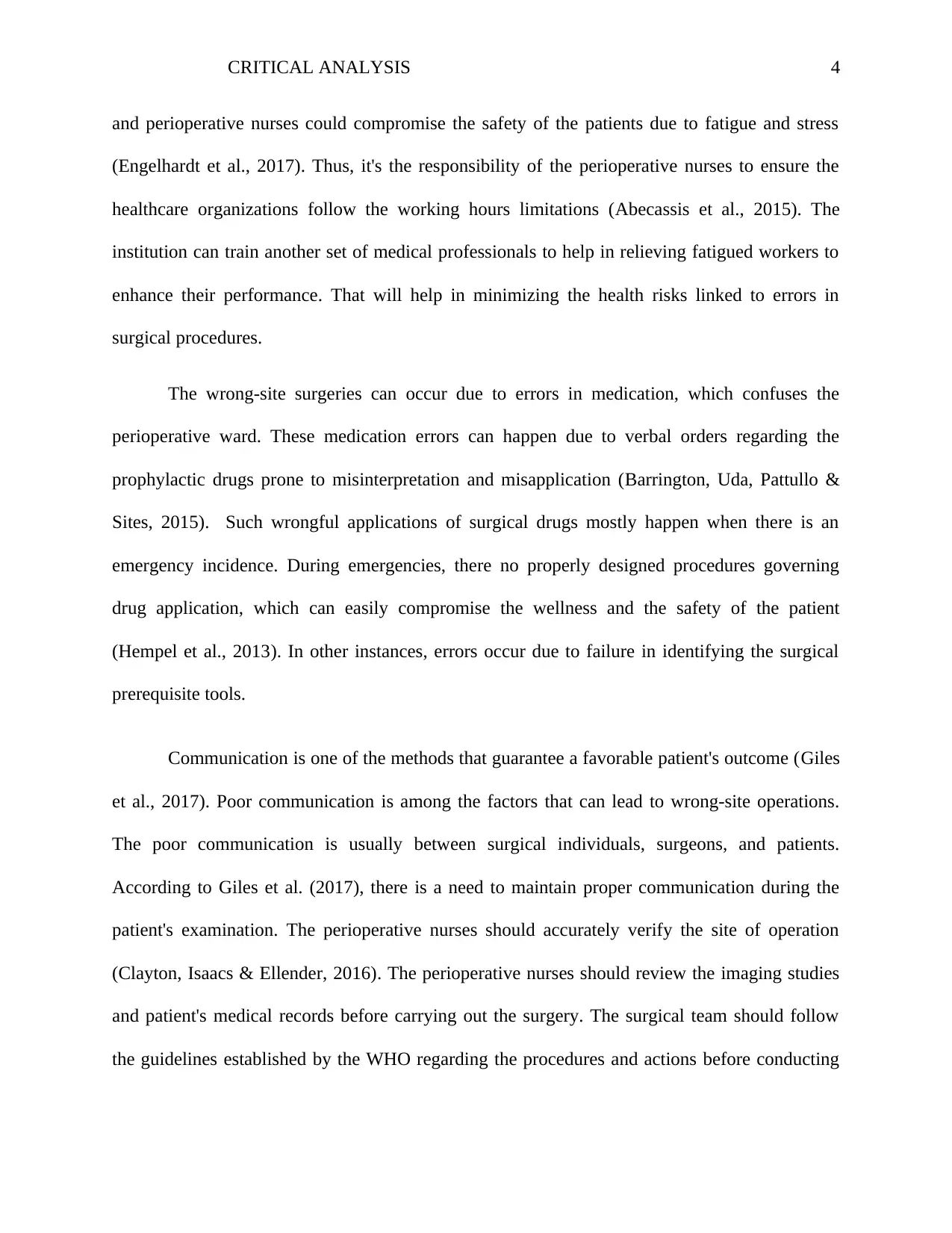
CRITICAL ANALYSIS 4
and perioperative nurses could compromise the safety of the patients due to fatigue and stress
(Engelhardt et al., 2017). Thus, it's the responsibility of the perioperative nurses to ensure the
healthcare organizations follow the working hours limitations (Abecassis et al., 2015). The
institution can train another set of medical professionals to help in relieving fatigued workers to
enhance their performance. That will help in minimizing the health risks linked to errors in
surgical procedures.
The wrong-site surgeries can occur due to errors in medication, which confuses the
perioperative ward. These medication errors can happen due to verbal orders regarding the
prophylactic drugs prone to misinterpretation and misapplication (Barrington, Uda, Pattullo &
Sites, 2015). Such wrongful applications of surgical drugs mostly happen when there is an
emergency incidence. During emergencies, there no properly designed procedures governing
drug application, which can easily compromise the wellness and the safety of the patient
(Hempel et al., 2013). In other instances, errors occur due to failure in identifying the surgical
prerequisite tools.
Communication is one of the methods that guarantee a favorable patient's outcome (Giles
et al., 2017). Poor communication is among the factors that can lead to wrong-site operations.
The poor communication is usually between surgical individuals, surgeons, and patients.
According to Giles et al. (2017), there is a need to maintain proper communication during the
patient's examination. The perioperative nurses should accurately verify the site of operation
(Clayton, Isaacs & Ellender, 2016). The perioperative nurses should review the imaging studies
and patient's medical records before carrying out the surgery. The surgical team should follow
the guidelines established by the WHO regarding the procedures and actions before conducting
and perioperative nurses could compromise the safety of the patients due to fatigue and stress
(Engelhardt et al., 2017). Thus, it's the responsibility of the perioperative nurses to ensure the
healthcare organizations follow the working hours limitations (Abecassis et al., 2015). The
institution can train another set of medical professionals to help in relieving fatigued workers to
enhance their performance. That will help in minimizing the health risks linked to errors in
surgical procedures.
The wrong-site surgeries can occur due to errors in medication, which confuses the
perioperative ward. These medication errors can happen due to verbal orders regarding the
prophylactic drugs prone to misinterpretation and misapplication (Barrington, Uda, Pattullo &
Sites, 2015). Such wrongful applications of surgical drugs mostly happen when there is an
emergency incidence. During emergencies, there no properly designed procedures governing
drug application, which can easily compromise the wellness and the safety of the patient
(Hempel et al., 2013). In other instances, errors occur due to failure in identifying the surgical
prerequisite tools.
Communication is one of the methods that guarantee a favorable patient's outcome (Giles
et al., 2017). Poor communication is among the factors that can lead to wrong-site operations.
The poor communication is usually between surgical individuals, surgeons, and patients.
According to Giles et al. (2017), there is a need to maintain proper communication during the
patient's examination. The perioperative nurses should accurately verify the site of operation
(Clayton, Isaacs & Ellender, 2016). The perioperative nurses should review the imaging studies
and patient's medical records before carrying out the surgery. The surgical team should follow
the guidelines established by the WHO regarding the procedures and actions before conducting
Paraphrase This Document
Need a fresh take? Get an instant paraphrase of this document with our AI Paraphraser
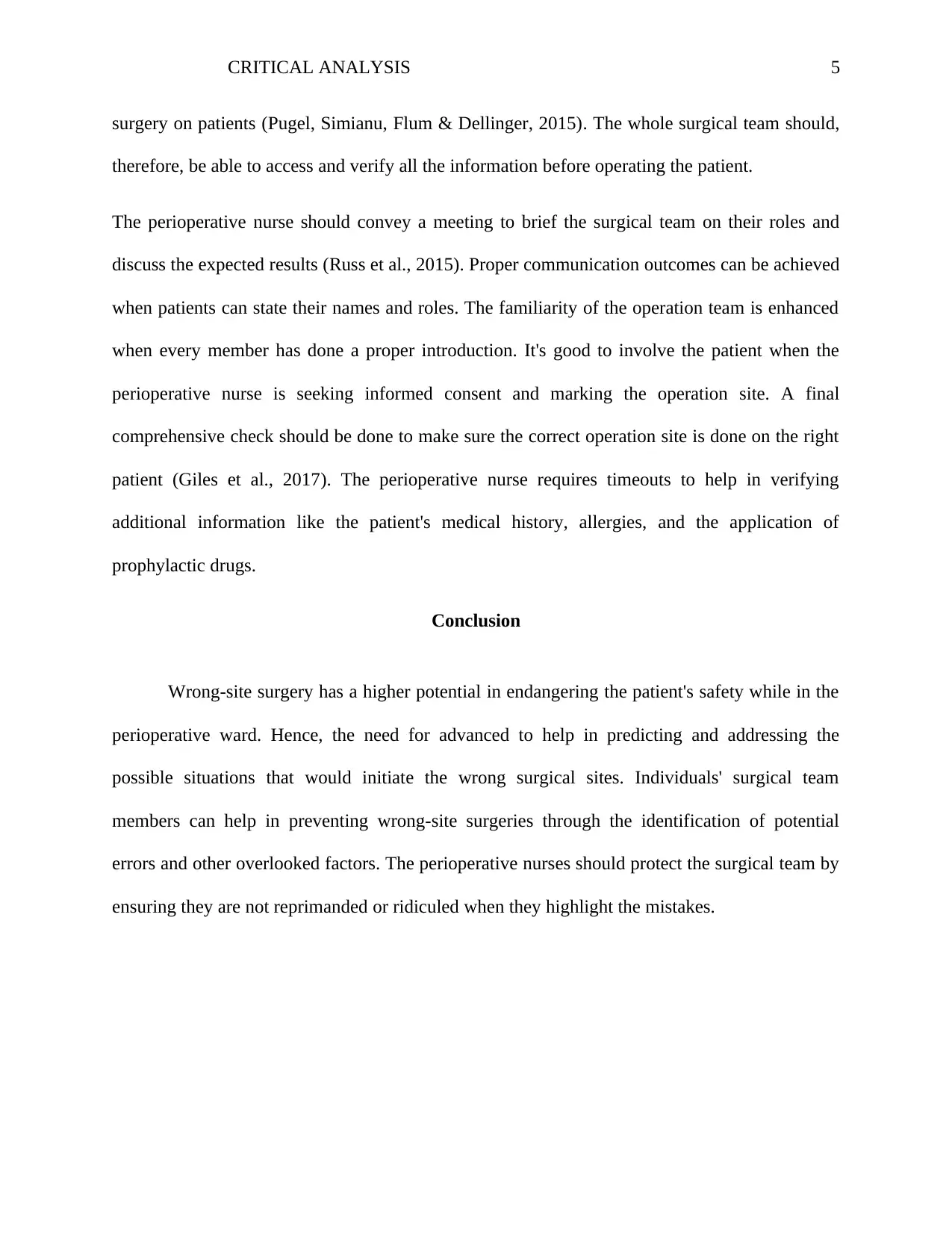
CRITICAL ANALYSIS 5
surgery on patients (Pugel, Simianu, Flum & Dellinger, 2015). The whole surgical team should,
therefore, be able to access and verify all the information before operating the patient.
The perioperative nurse should convey a meeting to brief the surgical team on their roles and
discuss the expected results (Russ et al., 2015). Proper communication outcomes can be achieved
when patients can state their names and roles. The familiarity of the operation team is enhanced
when every member has done a proper introduction. It's good to involve the patient when the
perioperative nurse is seeking informed consent and marking the operation site. A final
comprehensive check should be done to make sure the correct operation site is done on the right
patient (Giles et al., 2017). The perioperative nurse requires timeouts to help in verifying
additional information like the patient's medical history, allergies, and the application of
prophylactic drugs.
Conclusion
Wrong-site surgery has a higher potential in endangering the patient's safety while in the
perioperative ward. Hence, the need for advanced to help in predicting and addressing the
possible situations that would initiate the wrong surgical sites. Individuals' surgical team
members can help in preventing wrong-site surgeries through the identification of potential
errors and other overlooked factors. The perioperative nurses should protect the surgical team by
ensuring they are not reprimanded or ridiculed when they highlight the mistakes.
surgery on patients (Pugel, Simianu, Flum & Dellinger, 2015). The whole surgical team should,
therefore, be able to access and verify all the information before operating the patient.
The perioperative nurse should convey a meeting to brief the surgical team on their roles and
discuss the expected results (Russ et al., 2015). Proper communication outcomes can be achieved
when patients can state their names and roles. The familiarity of the operation team is enhanced
when every member has done a proper introduction. It's good to involve the patient when the
perioperative nurse is seeking informed consent and marking the operation site. A final
comprehensive check should be done to make sure the correct operation site is done on the right
patient (Giles et al., 2017). The perioperative nurse requires timeouts to help in verifying
additional information like the patient's medical history, allergies, and the application of
prophylactic drugs.
Conclusion
Wrong-site surgery has a higher potential in endangering the patient's safety while in the
perioperative ward. Hence, the need for advanced to help in predicting and addressing the
possible situations that would initiate the wrong surgical sites. Individuals' surgical team
members can help in preventing wrong-site surgeries through the identification of potential
errors and other overlooked factors. The perioperative nurses should protect the surgical team by
ensuring they are not reprimanded or ridiculed when they highlight the mistakes.
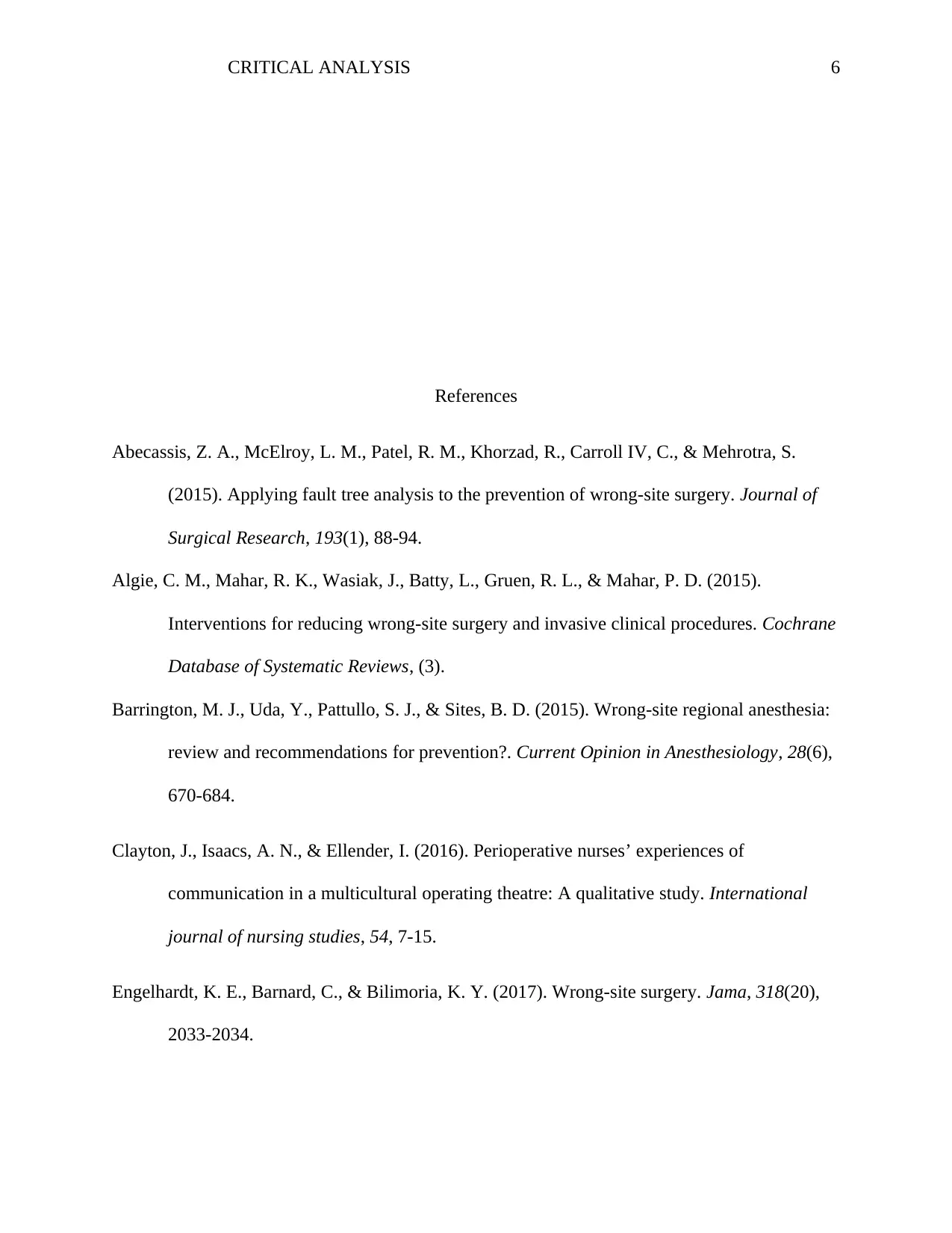
CRITICAL ANALYSIS 6
References
Abecassis, Z. A., McElroy, L. M., Patel, R. M., Khorzad, R., Carroll IV, C., & Mehrotra, S.
(2015). Applying fault tree analysis to the prevention of wrong-site surgery. Journal of
Surgical Research, 193(1), 88-94.
Algie, C. M., Mahar, R. K., Wasiak, J., Batty, L., Gruen, R. L., & Mahar, P. D. (2015).
Interventions for reducing wrong‐site surgery and invasive clinical procedures. Cochrane
Database of Systematic Reviews, (3).
Barrington, M. J., Uda, Y., Pattullo, S. J., & Sites, B. D. (2015). Wrong-site regional anesthesia:
review and recommendations for prevention?. Current Opinion in Anesthesiology, 28(6),
670-684.
Clayton, J., Isaacs, A. N., & Ellender, I. (2016). Perioperative nurses’ experiences of
communication in a multicultural operating theatre: A qualitative study. International
journal of nursing studies, 54, 7-15.
Engelhardt, K. E., Barnard, C., & Bilimoria, K. Y. (2017). Wrong-site surgery. Jama, 318(20),
2033-2034.
References
Abecassis, Z. A., McElroy, L. M., Patel, R. M., Khorzad, R., Carroll IV, C., & Mehrotra, S.
(2015). Applying fault tree analysis to the prevention of wrong-site surgery. Journal of
Surgical Research, 193(1), 88-94.
Algie, C. M., Mahar, R. K., Wasiak, J., Batty, L., Gruen, R. L., & Mahar, P. D. (2015).
Interventions for reducing wrong‐site surgery and invasive clinical procedures. Cochrane
Database of Systematic Reviews, (3).
Barrington, M. J., Uda, Y., Pattullo, S. J., & Sites, B. D. (2015). Wrong-site regional anesthesia:
review and recommendations for prevention?. Current Opinion in Anesthesiology, 28(6),
670-684.
Clayton, J., Isaacs, A. N., & Ellender, I. (2016). Perioperative nurses’ experiences of
communication in a multicultural operating theatre: A qualitative study. International
journal of nursing studies, 54, 7-15.
Engelhardt, K. E., Barnard, C., & Bilimoria, K. Y. (2017). Wrong-site surgery. Jama, 318(20),
2033-2034.
⊘ This is a preview!⊘
Do you want full access?
Subscribe today to unlock all pages.

Trusted by 1+ million students worldwide
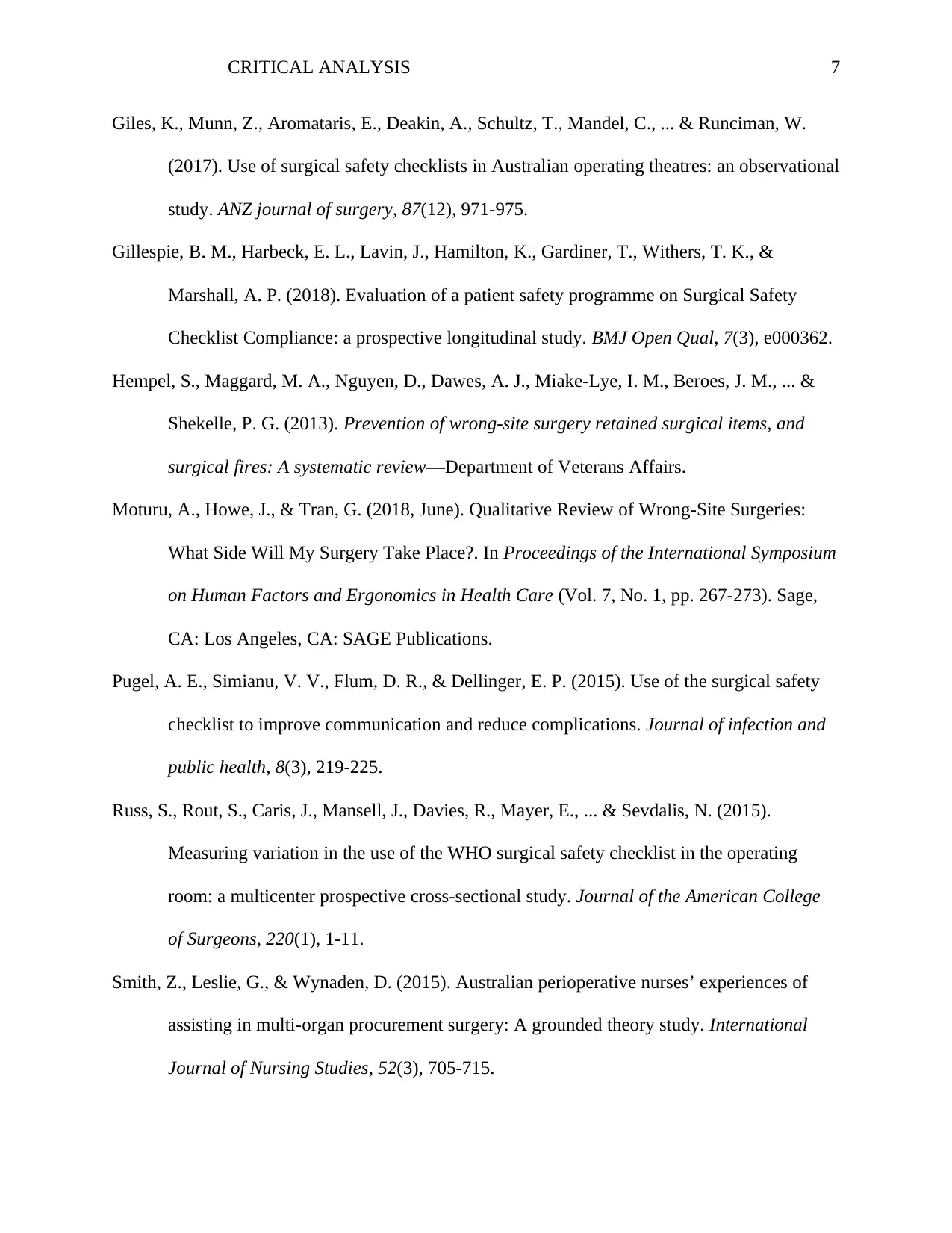
CRITICAL ANALYSIS 7
Giles, K., Munn, Z., Aromataris, E., Deakin, A., Schultz, T., Mandel, C., ... & Runciman, W.
(2017). Use of surgical safety checklists in Australian operating theatres: an observational
study. ANZ journal of surgery, 87(12), 971-975.
Gillespie, B. M., Harbeck, E. L., Lavin, J., Hamilton, K., Gardiner, T., Withers, T. K., &
Marshall, A. P. (2018). Evaluation of a patient safety programme on Surgical Safety
Checklist Compliance: a prospective longitudinal study. BMJ Open Qual, 7(3), e000362.
Hempel, S., Maggard, M. A., Nguyen, D., Dawes, A. J., Miake-Lye, I. M., Beroes, J. M., ... &
Shekelle, P. G. (2013). Prevention of wrong-site surgery retained surgical items, and
surgical fires: A systematic review—Department of Veterans Affairs.
Moturu, A., Howe, J., & Tran, G. (2018, June). Qualitative Review of Wrong-Site Surgeries:
What Side Will My Surgery Take Place?. In Proceedings of the International Symposium
on Human Factors and Ergonomics in Health Care (Vol. 7, No. 1, pp. 267-273). Sage,
CA: Los Angeles, CA: SAGE Publications.
Pugel, A. E., Simianu, V. V., Flum, D. R., & Dellinger, E. P. (2015). Use of the surgical safety
checklist to improve communication and reduce complications. Journal of infection and
public health, 8(3), 219-225.
Russ, S., Rout, S., Caris, J., Mansell, J., Davies, R., Mayer, E., ... & Sevdalis, N. (2015).
Measuring variation in the use of the WHO surgical safety checklist in the operating
room: a multicenter prospective cross-sectional study. Journal of the American College
of Surgeons, 220(1), 1-11.
Smith, Z., Leslie, G., & Wynaden, D. (2015). Australian perioperative nurses’ experiences of
assisting in multi-organ procurement surgery: A grounded theory study. International
Journal of Nursing Studies, 52(3), 705-715.
Giles, K., Munn, Z., Aromataris, E., Deakin, A., Schultz, T., Mandel, C., ... & Runciman, W.
(2017). Use of surgical safety checklists in Australian operating theatres: an observational
study. ANZ journal of surgery, 87(12), 971-975.
Gillespie, B. M., Harbeck, E. L., Lavin, J., Hamilton, K., Gardiner, T., Withers, T. K., &
Marshall, A. P. (2018). Evaluation of a patient safety programme on Surgical Safety
Checklist Compliance: a prospective longitudinal study. BMJ Open Qual, 7(3), e000362.
Hempel, S., Maggard, M. A., Nguyen, D., Dawes, A. J., Miake-Lye, I. M., Beroes, J. M., ... &
Shekelle, P. G. (2013). Prevention of wrong-site surgery retained surgical items, and
surgical fires: A systematic review—Department of Veterans Affairs.
Moturu, A., Howe, J., & Tran, G. (2018, June). Qualitative Review of Wrong-Site Surgeries:
What Side Will My Surgery Take Place?. In Proceedings of the International Symposium
on Human Factors and Ergonomics in Health Care (Vol. 7, No. 1, pp. 267-273). Sage,
CA: Los Angeles, CA: SAGE Publications.
Pugel, A. E., Simianu, V. V., Flum, D. R., & Dellinger, E. P. (2015). Use of the surgical safety
checklist to improve communication and reduce complications. Journal of infection and
public health, 8(3), 219-225.
Russ, S., Rout, S., Caris, J., Mansell, J., Davies, R., Mayer, E., ... & Sevdalis, N. (2015).
Measuring variation in the use of the WHO surgical safety checklist in the operating
room: a multicenter prospective cross-sectional study. Journal of the American College
of Surgeons, 220(1), 1-11.
Smith, Z., Leslie, G., & Wynaden, D. (2015). Australian perioperative nurses’ experiences of
assisting in multi-organ procurement surgery: A grounded theory study. International
Journal of Nursing Studies, 52(3), 705-715.
Paraphrase This Document
Need a fresh take? Get an instant paraphrase of this document with our AI Paraphraser
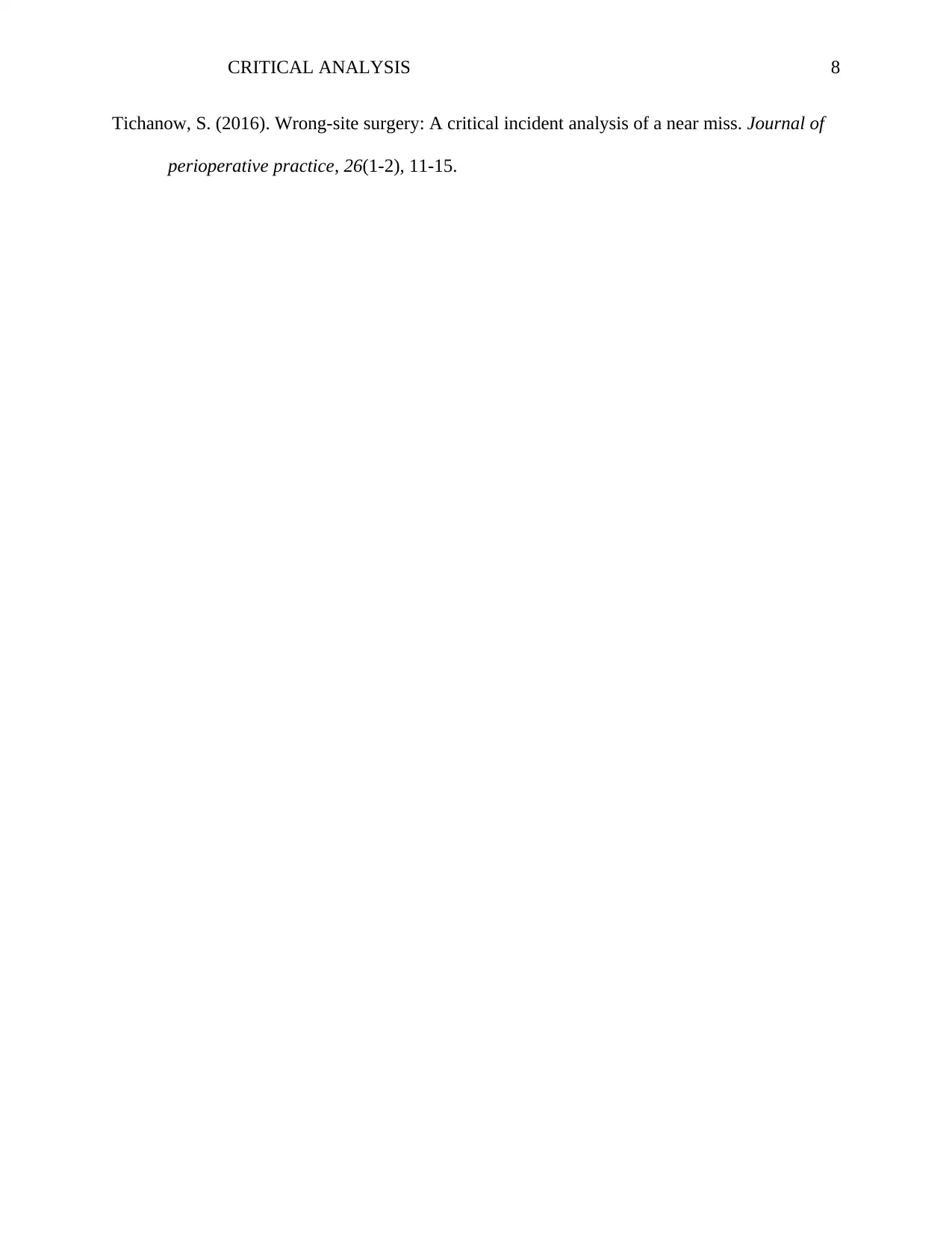
CRITICAL ANALYSIS 8
Tichanow, S. (2016). Wrong-site surgery: A critical incident analysis of a near miss. Journal of
perioperative practice, 26(1-2), 11-15.
Tichanow, S. (2016). Wrong-site surgery: A critical incident analysis of a near miss. Journal of
perioperative practice, 26(1-2), 11-15.
1 out of 8
Related Documents
Your All-in-One AI-Powered Toolkit for Academic Success.
+13062052269
info@desklib.com
Available 24*7 on WhatsApp / Email
![[object Object]](/_next/static/media/star-bottom.7253800d.svg)
Unlock your academic potential
Copyright © 2020–2025 A2Z Services. All Rights Reserved. Developed and managed by ZUCOL.





